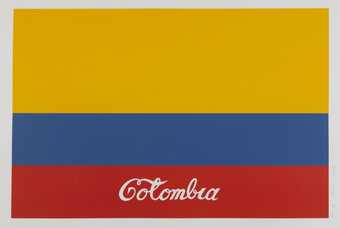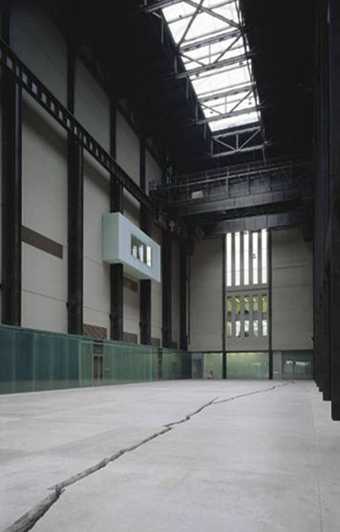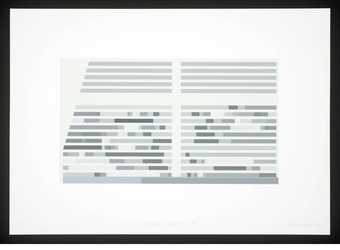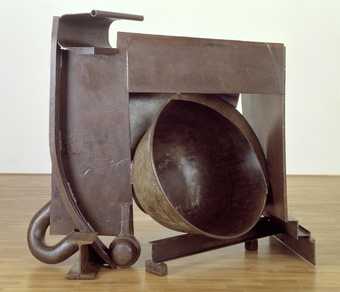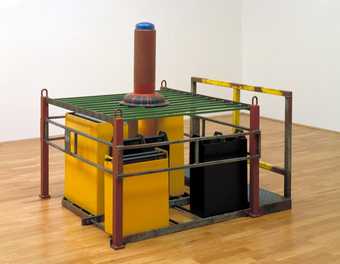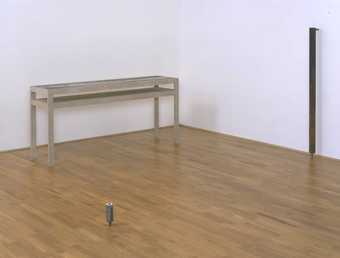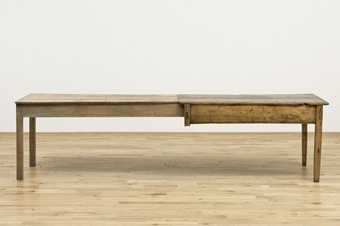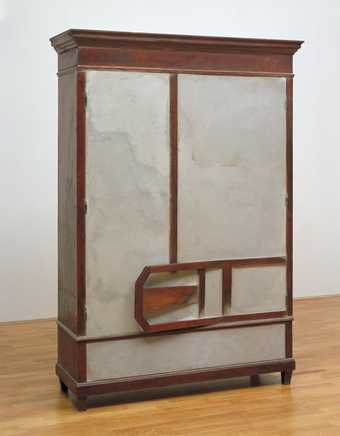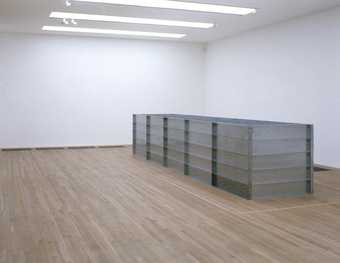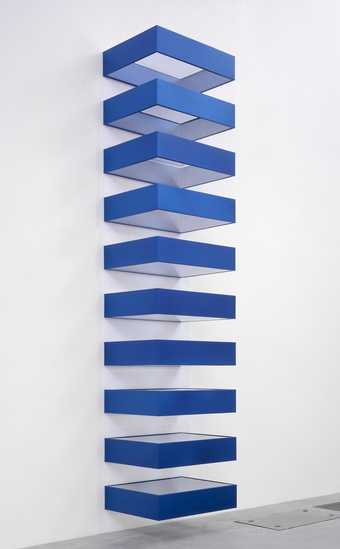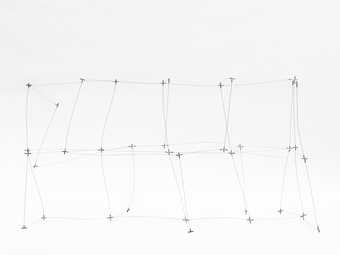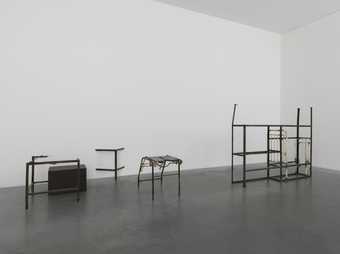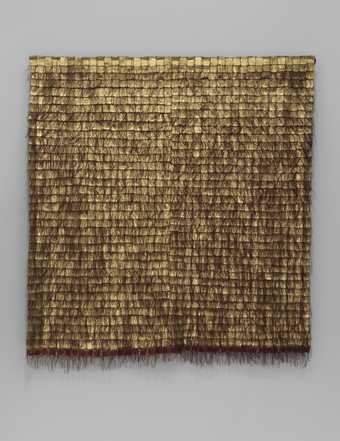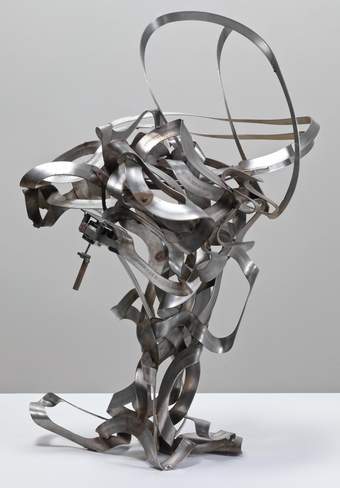
In Tate Modern
- Artist
- Doris Salcedo born 1958
- Medium
- Steel cot, steel shelving, rubber, 10 plastic dolls and pig intestine
- Dimensions
- Displayed: 1870 × 2410 × 460 mm, 65 kg
- Collection
- Tate
- Acquisition
- Purchased 2002
- Reference
- T07836
Summary
This is one of several Untitled works that Salcedo created in 1985-9 using such discarded steel-frame furniture as hospital beds, trolleys and infants’ cribs in combination with animal fibres, steel shelving and elements made of plastic, wax and fabric. Untitled, 1987 was made from a steel shelving unit and the two ends of a hospital cot cut and welded to make a single object. Salcedo inverted the tall shelving unit, cut off one of its legs and bent the other three inwards. Further abstracting the original form, parts of the shelving – comprising five levels (including the top) separated by a central strut all made of the same steel L-section sprayed with bluish green paint – were roughly and unevenly removed, leaving raw edges and corners inside the frame. To fit the ends of the hospital cot into the shelving frame, the artist cut them and reset them at right angles, so that they appear bent into the frame. The taller cot end is bent at one side only; the shorter is bent at both sides and its legs have been severed to make it fit to the level of the second shelf. One cot foot stands on the floor outside the shelving; one on the floor inside; the other two legs are welded into the L-section and stand on the bottom of the inverted support. Set into ten of the many internal corners in the hybrid steel structure, tiny plastic dolls are partially visible under lengths of pig intestine bound around the metal frame. Salcedo has explained that these figures are: ‘regular plastic dolls, that you can find anywhere, small naked babies, I have seen similar ones in many countries, they are standard cheap toys. I took those dolls and threw them in very hot casting wax, so they become swollen and begin to melt. [sic] At that point I gave them different shapes.’ (Quoted from email to sculpture conservator Bryony Bery, 29 April 2003, Tate Sculpture Conservation file.) From a distance the sculpture is an abstract linear composition of scuffed and welded metal in three dimensions; only on careful examination at close quarters are the shadowy figures of the plastic babies visible, erupting like strange growths in the wounds of the severed steel.
Salcedo studied art and art history at Bogotá University (BFA 1980) where she focused on painting and theatre and was particularly inspired by the painter Beatriz Gonzalez (born 1938). She began making sculpture in New York in the early 1980s, while attending New York University (MA 1984). Here she encountered the work of Joseph Beuys (1921-86), whose notion of ‘social sculpture’ – integrating political awareness with making – and his focus on materials to convey specific meanings were a significant influence on her. She began to think of sculpture as ‘a crossroad, a meeting point’ (quoted in Basualdo, p.11), of ideology, theory, materials and objects and she began to make sculpture that combined the aesthetics of minimalism with social critique. Salcedo’s return to Bogotá in 1985 coincided with a resumption of hostilities between guerrillas and the Colombian government in the civil war that had been going on since 1964. That November, the occupation of the Bogotá Palace of Justice by the forces of the M-19 guerrilla group led to the deaths of all thirty-five guerrillas plus eleven Supreme Court Justices. The event inspired Salcedo with the desire to make work speaking of these violent events and at the same time to maintain a critical distance from Colombian society. Unlike many of her later sculptural groups that were derived directly from the traumatic impact of particular aspects of the civil war, such as the Atrabiliarios
(1991-6) initially made from the shoes of people found in mass graves and the Unland (1995-8) group based on the experiences of children who had witnessed their parents’ murder (T07253), the earlier series to which Untitled, 1987 belongs was not drawn from any single aspect of Colombia’s political violence but from a more generalised sense of psychological damage and unease. Salcedo has commented:
The fact that I am a woman working from the periphery, working in a third world country undergoing a civil war, provides a distance and a privileged perspective on our absurd reality. My work is about human experience driven ad absurdum by violence, insensibility and fragility. I am not making monuments. It is public art. Most things that we do are political in this country. Art is a public vocation – it goes out into the public arena.
(Quoted in Salcedo, p.84.)
The tortuously fused elements of Untitled suggest a painful attempt at collaboration between two different systems of support, forced together reluctantly and unable to split apart.
Further reading:
Doris Salcedo, ‘Memoirs from Beyond the Grave’, Tate, The Art Magazine, Issue 21, 2000, p.84.
Carlos Basualdo, Nancy Princenthal and Andreas Huyssen, Doris Salcedo, London 2000, p.43, reproduced p.42 in colour.
Unland: Doris Salcedo: New Work, exhibition brochure, San Francisco Museum of Modern Art, 1999.
Elizabeth Manchester
December 2007
Does this text contain inaccurate information or language that you feel we should improve or change? We would like to hear from you.
Display caption
Shortly after returning to her native Bogotà from New York in the mid-1980s, Salcedo created a series of sculptures made from discarded pieces of furniture such as the bedsteads used here. These objects conjure up ideas of protection, care and confinement. Broken and dysfunctional, the beds have been tied together with animal fibre in what appears to be a repair doomed from the outset to failure. The result is a construction whose fragility becomes a poetic metaphor for the human condition.
Gallery label, July 2007
Does this text contain inaccurate information or language that you feel we should improve or change? We would like to hear from you.
Explore
- abstraction(8,615)
-
- non-representational(6,161)
-
- geometric(3,072)
You might like
-
Antonio Caro Colombia
1977 -
Doris Salcedo Shibboleth I
2007 -
Alison Turnbull Plant Bands and Systematic Sections
2007 -
Sir Anthony Caro The Soldier’s Tale
1983 -
John Gibbons The Awaiting
1991–2 -
Miroslaw Balka [diameter]7,5 x 159 x 16,5 - 195 x 47 x 90 - [diameter]6 x 18 cm
1991 -
Doris Salcedo Unland: audible in the mouth
1998 -
Doris Salcedo Untitled
1998 -
Donald Judd Untitled (DJ-89-40)
1989 -
Donald Judd Untitled
1990 -
Gego (Gertrud Goldschmidt) Horizontal Square Reticulárea 71/10
1971 -
Feliza Bursztyn The Mechanical Ballet
1979 -
Doris Salcedo Untitled
1986–7 -
Olga de Amaral Alchemy 50
1987 -
Feliza Bursztyn Untitled
1968

